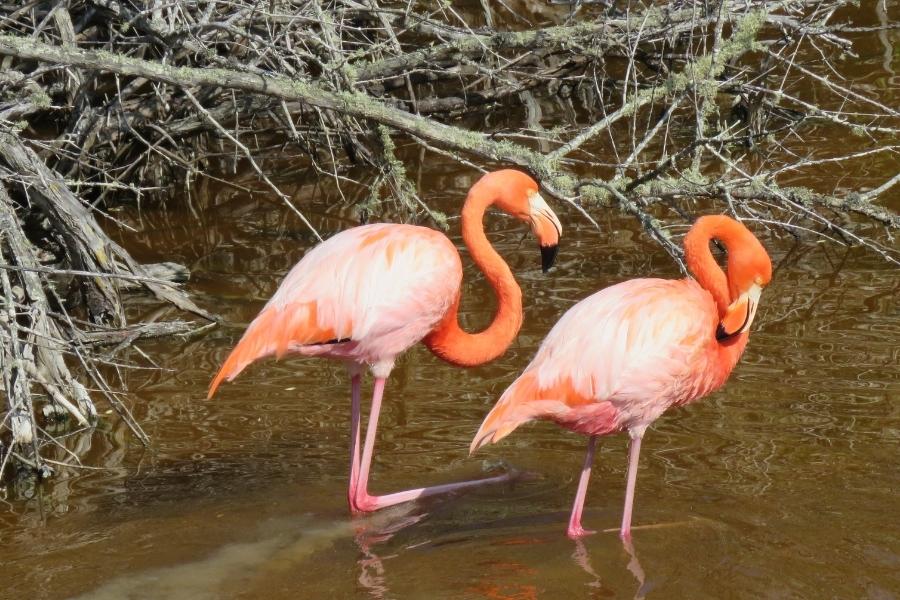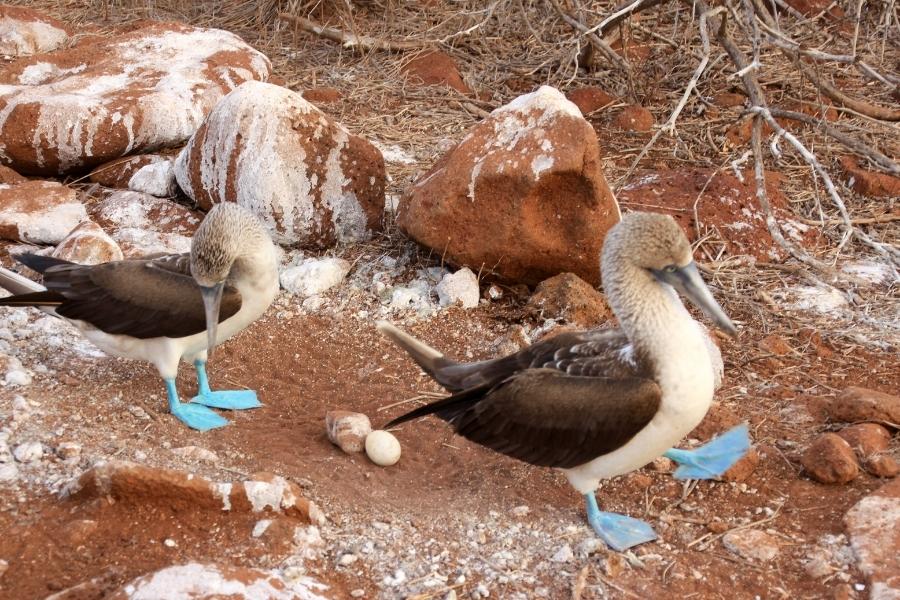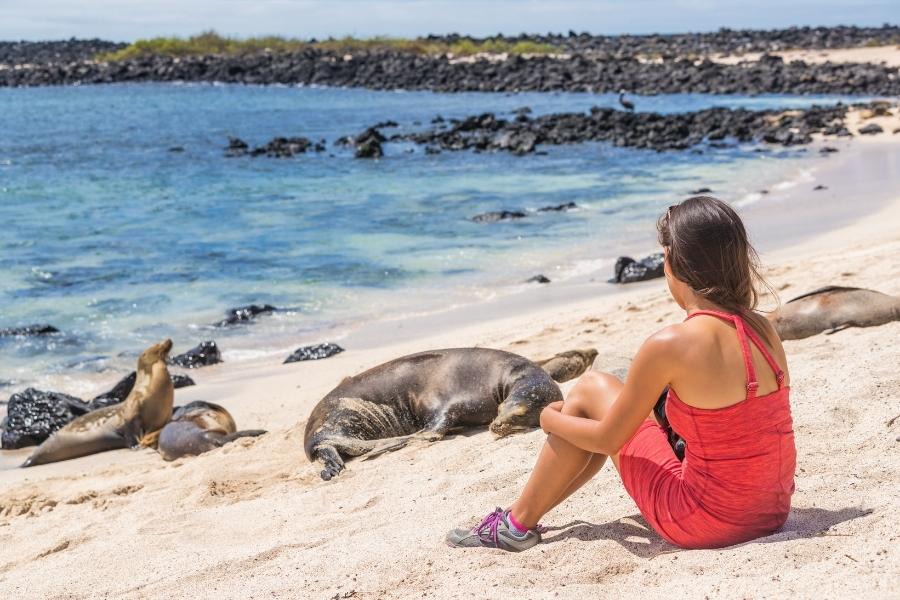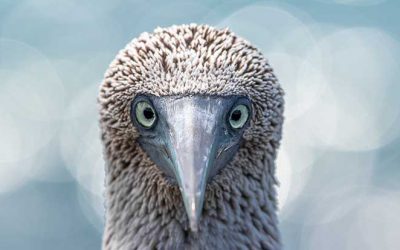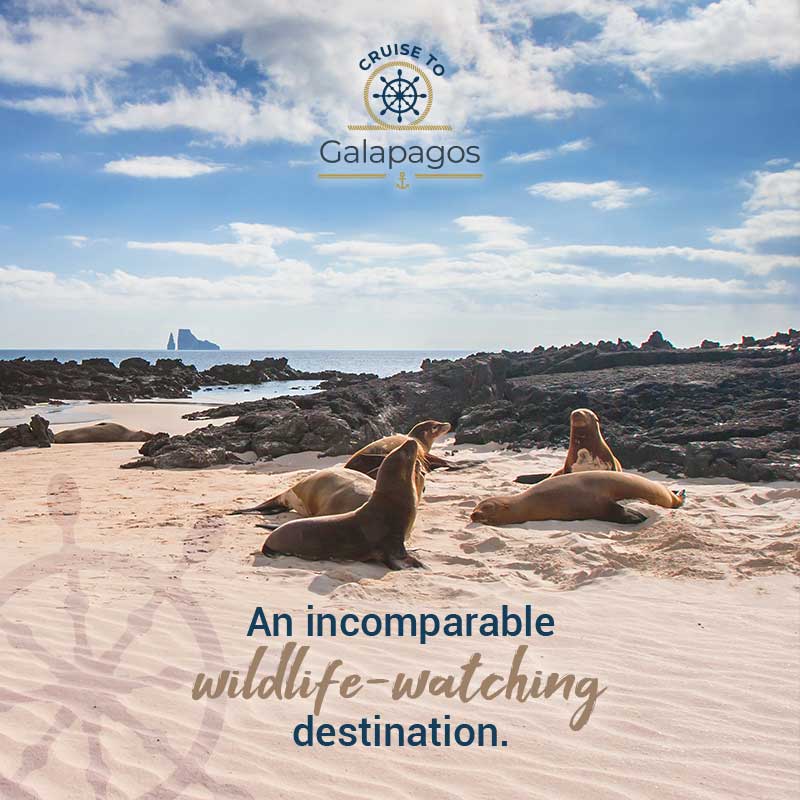Galapagos Islands Month by Month
Stay up to date with our most recent news and updates
One of the most frequently asked questions among travelers looking for a natural getaway to the Galapagos Islands is, when is the best time to do it? With so many months to choose from, how do you decide? The answer depends on the time you are looking for. Below we have listed each month and valuable information on what you can expect from the weather, wildlife, and activities to do in the Galapagos month by month.
Read until the end, so you don’t miss any detail of the Galapagos month by month, and get ready to live an unforgettable experience during your next vacation in the Enchanted Islands.
JANUARY
The year begins and so does the rainy season in Galapagos, but wait a minute, that’s not a bad thing at all, because at this time Galapagos land birds such as Darwin finches, Yellow Warbler, among others, begin their mating rituals to nest after the first rains. Similarly, the males of the adult marine iguanas on Española Island, acquire bright colors (green, red, and black) to attract the attention of females and to get a partner for the mating season.
Green sea turtles also take advantage of this month to arrive at the beaches of Galapagos to lay their eggs and begin their nesting period. It is also very likely to see large numbers of land iguanas as they begin their reproductive cycle on Isabela Island. Both water and air temperatures increase and remain warm until June, which creates a perfect environment to enjoy activities on land and in the water. This is an ideal time for snorkeling.
FEBRUARY
February in Galapagos, like January, is a good month for the wildlife of the different islands, as their fauna is constantly active. At Cormorant Point (Floreana), the great flamingos begin to nest, and the proud future parents prepare to care for their precious egg (females rarely lay two eggs) together, in an incubation process that will take around 30 days.
Just like other Galapagos land birds, the masked boobies on Española Island are at the end of their nesting season, so soon you might be lucky enough to spot their beautiful newly hatched chicks along the trails of this island.
Not only Galapagos birds are active in February, also marine iguanas are in their nesting season on Santa Cruz Island. The Galapagos weather in February remains spectacular for water activities, the highest temperature of the water reaches 28 °C (ca. 82 °F).
If you are ready to visit the Galapagos Islands in February, and would also like to spot penguins, you may have to go further west in the archipelago. Therefore, between February and April, which are warm months, we recommend visiting the western islands such as Isabela and Fernandina to be able to observe Galapagos penguins (most have followed the cold waters to the west, near to the outcropping areas).
The great flamingo is one of the most beautiful birds in the Galapagos Islands, and can be found on the Rabida, Santa Cruz, Isabela, Floreana, and Santiago islands.
MARCH
Galapagos weather in March features sporadic rains, intense sun, and high temperatures both on land and in the water. Air temperatures can reach 30°C (ca 86°F) throughout the archipelago, so even the western islands, which are characterized by the coldest waters, also have warm waters and visitors can enjoy an exceptional snorkeling.
March 21 is the beginning of the summer equinox, and the first Waved Albatrosses arrive to Española Island to begin their characteristic courtship ritual, which will last until June. On the other hand, Vicente Roca Point, on Isabela Island, can be another nice place to visit, since the Galapagos penguins are still active in the water and together with the tropical fish they offer a beautiful underwater show to visitors.
Navigation can be a bit intense on some coasts, especially those facing the north side of the archipelago, which can receive deep waves (swell waves) from the warm northern currents. But, don’t worry, the Galapagos Islands cruises are safely and very comfortable during navigation.
APRIL
If you are a Galapagos bird lover, a must-see place to visit in April is Suarez Point, where the Galapagos albatrosses have been arriving little by little since the end of March to begin their courtship ritual. You should know that Suarez Point is the only nesting site in the entire archipelago for these majestic birds.
Another important natural event that takes place during the month of April in Galapagos is the hatching of the eggs of the giant Galapagos tortoises, which comes to an end. You will be able to observe several baby turtles, especially in the hatcheries of Santa Cruz, Isabela and San Cristóbal.
In various island coasts, mainly on “Las Bachas” beach in Santa Cruz and Cormorant Point in Floreana, the hatching of green sea turtle eggs (Chelonia Mydas) begins. Likewise, on Isabela Island, land iguana eggs are also beginning to hatch.
The Galapagos weather in April is still rainy, so the islands still remain green. On the other hand, underwater good visibility continues for enthusiasts of water activities such as diving and snorkeling. Our Galapagos Islands experts consider April and May to be the best months in Galapagos for both weather, wildlife, and things to do.
MAY
During May, on North Seymour Island, the soft whistles of male blue-footed boobies looking for a bride begin to be heard. On the other hand, the females emit a loud “honk” to say that they are available and looking for a healthy mate to raise a beautiful chick together.
On Española Island, waved albatrosses begin laying eggs and begin their nesting season, and the Galapagos dusky-rumped petrel also begins its first nesting period.
Although some green turtle eggs have already hatched in other parts of the archipelago, as we mentioned in April, others continue their incubation process in Gardner Bay (Española) and Egas Port (Santiago).
Most of the marine iguana eggs will have already hatched from their nests in Santa Cruz, so you will be able to see small iguana hatchlings strolling along the shores, sunbathing on the Puerto Ayora pier, as well as through the streets of the town. Watch where you walk and try not to step on them!
The Galapagos weather in May begins to show slight effects, as the rains are significantly decreasing, and the Palo Santo trees begin to lose their foliage and the lands that were green, begin to dry out and show more brown tones.
JUNE
We have reached the middle of the year, and this is when the rainy and foggy season begins. However, the weather is still pleasant on the coasts. You can expect average daily temperatures of around 21°C – 24°C (c.a 70-76°F) with water temperatures around 24°C (c.a 76°F), perfect for swimming and enjoying life Marine.
In June, the giant tortoises of Santa Cruz Island seek to leave the rains and fog behind, migrating from the highlands to the lowlands in search of drier and more suitable places to nest. Don’t worry, despite this, you can still see them in the tourist ranches in the highlands of this island.
Wildlife activity on Santa Cruz Island is not the only one in June in the Galapagos. On North Seymour Island, male magnificent frigatebirds have begun puffing out their chests like big red balloons to attract a mate during the new breeding season.
On the other hand, the trade winds from the southeast return. Ocean currents are getting a little stronger and more nutrient-rich, so some pods of humpback whales migrating to equatorial latitudes along the coast of Ecuador are also beginning to arrive in the Galapagos Islands.
Humpback whales are seasonal visitors to the Galapagos Islands and normally arrives to the islands in June when the cool and dry season begins in the archipelago.
JULY
The most active season for Galapagos seabirds begins in July! In the eastern part of the archipelago, on Española Island, blue-footed boobies have begun their courtship ritual. This month is a good month to see them in their four nesting stages: eggs, chicks, juveniles, and subadults.
Besides, in the western part of the islands, on Fernandina and the western coasts of Isabela, the Galapagos flightless cormorants can be observed, also in their mating rituals, as well as other specimens already in their nesting stage.
On the other hand, the small and elusive lava lizards have also started their mating rituals, which will last until November. The female lava lizards are more colorful than at other times of the year, appearing with striking orange colors on their faces to attract their mate, so you can easily recognize them, since the males have gray tones.
The Galapagos water temperature in July does not exceed 21 °C (approx. 70 °F), it is probably a bit cold for some travelers, so they can wear a wetsuit, which will help keep the body warm mainly during snorkeling as well as diving. In addition, the probability of seeing cetaceans such as whales and dolphins, mainly off the west coast of Isabela in the Bolivar Channel, increases. If you decide to go on a cruise and would like to enjoy these sightings, be sure to book an itinerary that includes the Western Isles.
Galapagos blue boobies lay 2-3 eggs and are cared for by both parents for around 45 days.
You might be interested in: Top endemic species on the Galapagos Islands
AUGUST
In August, both seabirds and land birds are still active throughout the Galapagos Islands, in their courtship rituals, mating, or even nesting or raising their chicks.
On the Española and Santiago islands, the Galapagos hawk has begun its courtship ritual, later the females will lay 1-3 eggs which will hatch for 38 days. Besides, masked boobies and swallow-tailed gulls have started their nesting season on Genovesa Island, so you will probably see the first chicks hatch during your visit to this island.
On the other hand, after having nested in the lowlands, the Galapagos giant tortoises return to the highlands of Santa Cruz to feed and cool off a bit. Did you know that a giant Galapagos tortoise can live for more than a year without drinking or eating anything? These Galapagos reptiles have adapted impressively to the hostile conditions that their ancestors had to face in their beginnings on the islands. Interesting, right?
Ocean temperatures drop to 18 °C (approx. 64 °F), which obviously varies geographically between islands, with the western islands having lower temperatures and the eastern islands maintaining more comfortable temperatures. This temperature variation is due to the different sea currents that cross the archipelago.
Migratory shorebirds such as whimbrels birds, rudy turnstones birds, and others begin to arrive in the Galapagos and remain on the islands until March. On the other hand, life reborn during this month, the Galapagos sea lions births have begun, so if you decide to visit the western (Isabela – Bartolome – Rabida) and central (San Cristóbal – South Plaza – North Seymour) islands of the archipelago you will be able to observe these tender iconic Galapagos animals.
The observation of newborn Galapagos giant tortoises in their natural environment is not very common. However, they can be seen in the breeding centers that exist on the islands of Santa Cruz, San Cristóbal and Isabela.
SEPTEMBER
Galapagos penguins show notable activity on Bartolomé Island, as some families of penguins living on this island have returned from the western islands. Snorkeling and penguin enthusiasts will be able to enjoy unforgettable encounters with these beautiful creatures.
In addition, the Galapagos sea lions are also active, since the females have reached their mating season again. The male sea lions (Bulls) that collect the harem, they are constantly barking and fighting. Did you know that, a male sea lion’s harem can have up to 15 females, so fights on the shores are intense?
Don’t worry, this does not represent any danger for visitors, as long as they keep a minimum distance of 2 meters as indicated by the regulations of the Galapagos National Park.
Galapagos penguins are the only penguin species in the world that live north of the equator. They can be seen throughout the year on Isabela and Fernandina Islands in the western part of the Galapagos archipelago.
OCTOBER
In October, the lava heron begins its breeding season, which will last until March. These incredible coastal birds, which camouflage themselves among the volcanic rocks with their gray plumage on the shores of the archipelago, lay between 1-3 eggs and are incubated by their parents for approximately 3 weeks.
On the other hand, blue-footed boobies, after an incubation period of approximately 45 days, are raising their chicks throughout Española Island and Vicente Roca Point (Isabela). Therefore, if you want to observe your newly hatched chicks, the perfect opportunity to do so may be in October.
Galapagos weather in October is cool and dry, so not every day will be sunny, although with less chance of rain. Remember that even if you are not in direct sunlight, you should use sunscreen, since the Galapagos Islands are on the equator and the sun’s rays are more intense than in other parts of the world.
During this month the temperatures are cool and ideal (21°C – 23°C / 70°F – 74°F) for some activities such as hiking and wildlife observation, since you will not have to look for shade to protect yourself from the intense sunny rays like in other months of the year.
NOVEMBER
If you are a marine life enthusiast, November in the Galapagos Islands will not disappoint you! Green sea turtles are beginning their mating season, and the best news is that you will be able to observe them frequently in almost the entire archipelago.
In addition, you will be able to observe several nurseries of tender sea lion pups with their mothers who teach them to swim in shallow waters. However, remember not to disturb them or get too close, as their mothers are very protective and could get angry. On the other hand, this is an experience that you will love.
As we tell you before, some species be active both on land and in the water, and, the Galapagos birds are not far behind.
The Galapagos dusky-rumped petrel bird begins its second nesting period. This bird lays a single egg, which will be incubated by both parents for 50 days. You can see them mainly on the Isabela, Santiago, Santa Cruz, San Cristóbal, and Floreana islands and also on the rocks and islets near these islands.
Galapagos weather in November shows small variations, since the transition period from cool and dry season to warm and wet season begins gradually. In addition, the temperature of the water slowly rises again, so many fans of water activities such as paddleboarding, kayaking, snorkeling and diving, take the opportunity to have fun.
Galapagos sea lion watching is one of the most popular activities among visitors. They can be seen all year round on most of the shores of the Galapagos archipelago.
DECEMBER
After a wonderful year for wildlife in Galapagos, we have reached December. On land, the hatching of the giant tortoise eggs begins, which will last approximately until April. On the other hand, in the water, green sea turtles continue their mating rituals, and if you would like to spot them you can do so mainly on the coasts of Santa Cruz (Bachas Beach) and Floreana Island (Cormorant Point).
As if that were not enough, on Española Island, the first chicks of the Galapagos Albatross begin to shed their brown down to dress in white and gray plumage that will accompany them throughout their mature lives. In addition, on Genovesa Island the first red “bags” of male frigate birds are beginning to be sighted, which indicates the beginning of a new breeding season for these majestic Galapagos birds.
Galapagos weather in December starts with sunny days and high chances of rain. Plants in the dry areas begin to produce leaves, and the islands gradually turn “green” again. The start of the Galapagos wet and warm season is just around the corner.
If you are worried about the rains, let us tell you that there is nothing to worry about. The rains are usually at night, so you can take advantage of the day to explore and enjoy your vacation in these wonderful islands.
Thank you for reading this brief guide on the Galapagos month by month, we hope it will be useful to start planning your next visit to these incredible islands.
Contact our experts today and request a free-quote, or check out our best Galapagos Islands cruise deals by clicking here.
If you liked this post, you can share it with your friends, or if you want to know more information, you can subscribe to our newsletter and receive updates on the Galapagos Islands and the top travel destinations in Ecuador.
RELATED POST
Traveling to the Galapagos Islands in 2022: tips, what to do, and how to book the best trip ever
Learn more about the Galapagos Islands and how to make the most of your trip to this natural destination with this quick guide.
Blue-footed Booby Interesting Facts
The blue-footed boobies of the Galapagos Islands, as beautiful as they are unique. Discover here some interesting facts about them.

